Known by many as Lake Malibu, the actual name for this picturesque body of water is Malibou Lake. Created in 1922 as a getaway resort for fishing and swimming enthusiasts, Malibou Lake is located in Malibu, California, just over the hill from a community of multi-million dollar mansions and within the scenic Santa Monica Mountains National Recreation Area. It is bordered on the south and east by Malibu Creek State Park and by the Paramount Ranch National Park to the north and west. Many parts of the Santa Monica Mountains National Recreation Area are open to the public and consist of numerous hiking and horseback trails. In 1922, however, there were no state or national parks, and Malibu was part of a large ranch owned by the Rindge family.
Rancho Malibu dates back to 1848 when Leon Victor Prudhomme acquired the property from the widow of Jose Bartolome Tapia, its first historical owner and grandmother of his new wife, Maria. When the U.S. Land Commission began hearings in 1852 to segregate private land from public domain, Prudhomme put in his claim for the Rancho Malibu. Since no documents could be produced proving the early-day grant of Malibu to Tapia, the Commissioners turned down Prudhomme's claim. Despite the lack of clear title, Prudhomme remained on the land. Under his ownership, Rancho Malibu experienced great wealth, from the time gold was discovered in Sutter's Mill in 1848 until 1855 when ranch cattle were driven north to the gold fields and paid for in gold. By 1857, however, these prosperous days had ended and the real estate boom was over. A discouraged Prudhomme sought a buyer for his rancho.
Don Mateo Keller, born Matthew Keller in Ireland in 1811, came to California from Mexico after hearing that Rancho Malibu was for sale. He knew that Prudhomme had been denied legal title to the property by the U.S. Land Commission. Despite this, in 1857 Keller accepted a quit claim deed and paid the Prudhommes $1400 for the entire rancho – about ten cents an acre. Seven years later, with new support and better attorneys,
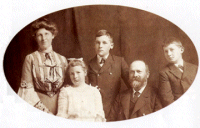 the U.S. District Court on October 24, 1864, rendered a decree confirming Keller's claim. The original boundaries of Tapia's Rancho Malibu were described as extending from a place called 'Topanga,' the dividing line between these lands and the Ranch of 'Santa Monica,' on the southeast, along the Pacific to a point called Mugu on the northwest, and bounded on the northeast by a ledge of rocks on the top of and extending the whole length of a range of mountains; and adjoining the lines of the ranchos of 'Las Virgines,' 'Triunfo,' 'Santa Ysabel,' and 'Conejo'. Although these boundaries encompassed approximately 44,300 acres, U.S District Court Judge Fletcher M. Haight conferred only 13,330 acres to Keller. Keller’s attempts to overturn this decision were unsuccessful, and the remaining 30,000+ acres were designated government land and later homesteaded. In 1870 the U.S. Surveyor General made a survey of the land. The map was approved, and on August 29, 1872, President Ulysses S. Grant granted the Rancho Topanga Malibu Sequit to Matthew Keller. Henceforth, all deeds to Malibu real estate are traceable to the land of Matthew Keller in the Topanga Malibu Sequit. Matthew Keller died in 1881 and his son, Henry Keller, succeeded him as owner of the Rancho Malibu.
the U.S. District Court on October 24, 1864, rendered a decree confirming Keller's claim. The original boundaries of Tapia's Rancho Malibu were described as extending from a place called 'Topanga,' the dividing line between these lands and the Ranch of 'Santa Monica,' on the southeast, along the Pacific to a point called Mugu on the northwest, and bounded on the northeast by a ledge of rocks on the top of and extending the whole length of a range of mountains; and adjoining the lines of the ranchos of 'Las Virgines,' 'Triunfo,' 'Santa Ysabel,' and 'Conejo'. Although these boundaries encompassed approximately 44,300 acres, U.S District Court Judge Fletcher M. Haight conferred only 13,330 acres to Keller. Keller’s attempts to overturn this decision were unsuccessful, and the remaining 30,000+ acres were designated government land and later homesteaded. In 1870 the U.S. Surveyor General made a survey of the land. The map was approved, and on August 29, 1872, President Ulysses S. Grant granted the Rancho Topanga Malibu Sequit to Matthew Keller. Henceforth, all deeds to Malibu real estate are traceable to the land of Matthew Keller in the Topanga Malibu Sequit. Matthew Keller died in 1881 and his son, Henry Keller, succeeded him as owner of the Rancho Malibu.
After a few years, Henry Keller sold the entire ranch to Frederick Hastings Rindge for $10 an acre. Born in 1857 in Cambridge, Massachusetts, Rindge was a Harvard graduate who, in 1883, inherited over $2 million from his father’s estate. Rindge married Rhoda May Knight in 1887, and shortly thereafter they moved to California. He purchased the Rancho Malibu in 1892 and built his ideal ranch house. Sadly, it burned to the ground in 1903; but in his 1898 book Happy Days in Southern California, Rindge described his land, home, and working cattle ranch as the fulfillment of his dream: "a farm near the ocean, and under the lee of the mountain, with a trout brook, wild trees, a lake, good soil, and excellent climate." He also envisioned the Malibu coast as someday becoming the “American Riviera”, a fairly accurate description of the area of today.
At the turn of the century, there were no roads to Malibu. Accessibility to the region was either by horseback, by boat, or by horse-drawn wagon over packed sand at low tide. In 1904, the Southern Pacific Railroad wanted to lay tracks that would link Santa Monica with their northern tracks which ended in Santa Barbara. A straight-line connection, however, would run right through Rindge’s Malibu Ranch. Because law prevented duplication of any existing railroad line, Rindge kept the Southern Pacific off his land by incorporating his own private railroad. Unfortunately, Frederick Rindge died suddenly the following year at the age of 48, and it was left to his widow, May, to carry out his plans. Completed in 1908, the 15 miles of private tracks were called the Hueneme, Malibu and Port Los Angeles Railway. May K. Rindge became its president, making her one of the very few women ever to become president of a railroad. The Rindge railroad was never a major line; it quit running in the 1920s after primarily serving to ship out hides and grains from the ranch and transport in needed supplies. Yet despite its relative insignificance, this little railroad stopped the encroachment of the mighty Southern Pacific, and consequently played a critical role in turning the tide of Los Angeles’ development away from the Malibu coast and inland to the San Fernando Valley.
Even though she faced a large inheritance tax and other high-interest taxes, May K. Rindge was able to carry out all her late husband’s plans for the ranch. As a result, in just over 20 years the ranch had become an extremely valuable piece of real estate. Her attempts to keep highways out of the property, however, were unsuccessful; soon after the county and state were granted right-of-way, the Roosevelt Highway was opened in 1926.
 Frederick and May K. Rindge had three children: Samuel, Frederick Jr., and Rhoda Agatha. Rhoda married Merritt Huntley Adamson, then superintendent of the Malibu Ranch. Adamson was a descendant of pioneers who came west to Oregon in Conestoga wagons. The family moved to the Arizona Territory, where his father, John Quincy Adamson, was elected to the Arizona Territorial Legislature. Merritt was born in Los Angeles in 1888. As a young man, after his father died, he took charge of the family sheep ranch in Arizona. There, he became a blood brother of the Havasupai Tribe, and later in college was nicknamed Great Chief White Smoke or simply Smoke Adamson. He attended the University of Southern California, and was captain of the last rugby football team. After graduating from USC Law School, Merrit went to work for Malibu Ranch where he became superintendent. There he met and married Rhoda Agatha Rindge in 1915.
Frederick and May K. Rindge had three children: Samuel, Frederick Jr., and Rhoda Agatha. Rhoda married Merritt Huntley Adamson, then superintendent of the Malibu Ranch. Adamson was a descendant of pioneers who came west to Oregon in Conestoga wagons. The family moved to the Arizona Territory, where his father, John Quincy Adamson, was elected to the Arizona Territorial Legislature. Merritt was born in Los Angeles in 1888. As a young man, after his father died, he took charge of the family sheep ranch in Arizona. There, he became a blood brother of the Havasupai Tribe, and later in college was nicknamed Great Chief White Smoke or simply Smoke Adamson. He attended the University of Southern California, and was captain of the last rugby football team. After graduating from USC Law School, Merrit went to work for Malibu Ranch where he became superintendent. There he met and married Rhoda Agatha Rindge in 1915.
Merritt Adamson's strength was farming, and he established the Adohr (Rhoda spelled backwards) Stock Farms, which became a very large milk producer. In the late 1920s, the Adamsons decided to build their dream house overlooking the Malibu coast. They hired the well-known architect Stiles O. Clements, and construction on the Adamson House began in 1929. Merritt and Rhoda first occupied the house during the summer months of 1930, but began living there year-round in 1937. During his lifetime, Merritt Adamson achieved many business and civic honors. When he died in 1949, Rhoda took over the stock farm, other family investments, and the Adamson House.
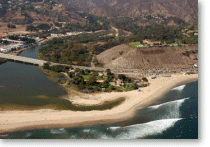 One special feature of the two-story house is the elevator, which was installed specifically for Mrs. Adamson in 1958. Six years after her death in 1962, the State of California purchased the property. In 1971, the president of Pepperdine University moved into the house as part of an effort to maintain it until it could be properly restored for the public. The Malibu Lagoon Interpretive Association was formed in 1981 and, after careful planning, the Adamson House opened as a museum in 1983. The property grounds consist of a pool with adjoining bathhouse expansively decorated with Malibu tile. Flagstone pathways wind through the pristine landscape, dotted with several gleaming fountains, all decorated with tile. The Adamson House, although visible from most places on the beach, is only accessible from the Pacific Coast Highway, a few hundred feet east of Malibu Lagoon State Beach.
One special feature of the two-story house is the elevator, which was installed specifically for Mrs. Adamson in 1958. Six years after her death in 1962, the State of California purchased the property. In 1971, the president of Pepperdine University moved into the house as part of an effort to maintain it until it could be properly restored for the public. The Malibu Lagoon Interpretive Association was formed in 1981 and, after careful planning, the Adamson House opened as a museum in 1983. The property grounds consist of a pool with adjoining bathhouse expansively decorated with Malibu tile. Flagstone pathways wind through the pristine landscape, dotted with several gleaming fountains, all decorated with tile. The Adamson House, although visible from most places on the beach, is only accessible from the Pacific Coast Highway, a few hundred feet east of Malibu Lagoon State Beach.
The Rindge family was always very protective of their property, and over the years they acquired a reputation for shooting trespassers. It was probably because of the threatening ambiance created by the Rindges that Malibou Lake is spelled slightly different than the surrounding area. In an attempt to distinguish their mountain resort from the Rindge’s Malibu, developers added an “o” to the lake’s name. After all, they wanted to attract vacationers, not frighten them away. Confusion over the actual name of the lake has continued through the years, especially since Malibou Lake is the same lake depicted on many maps as Malibu Lake. Furthermore, many businesses find greater name recognition in using Malibu Lake in naming their business.
Malibou Lake was the conception of Bertran Lackey and George Wilson. These two men believed the area around Malibu to be the perfect location for a secluded residential community surrounding a lake. Unfortunately, not only was there no lake in the area, in the early 1920s road access in the mountains was limited to mainly wagon trails.
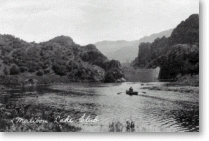 What would later become US Highway 101 was little more than a dirt path, and the Pacific Coast Highway extension through the Malibu area was still years away. To facilitate the creation of a lake, Wilson and Lackey shrewdly chose the convergence point of Medea and Triunfo Creeks, which were for the most part dry, and little more than a trickle even after a heavy rain. Building a dam on this site would not involve any huge engineering feats such as rerouting a major water flow, as is common with large-scale dam projects. While residential lot surveys were underway, dam construction began in November 1922 and was completed five months later. On June 19, 1923, a drawing for the cabin sites around the dry lakebed took place among the original members of the Malibou Lake Club (later called Malibou Lake Mountain Club). This drawing was followed by exchanges between those wanting waterfront sites and those who preferred hillside sites with views. The longest three years in the Mountain Club's history were between 1923 and 1926 when their “lake” remained dry as a bone.
What would later become US Highway 101 was little more than a dirt path, and the Pacific Coast Highway extension through the Malibu area was still years away. To facilitate the creation of a lake, Wilson and Lackey shrewdly chose the convergence point of Medea and Triunfo Creeks, which were for the most part dry, and little more than a trickle even after a heavy rain. Building a dam on this site would not involve any huge engineering feats such as rerouting a major water flow, as is common with large-scale dam projects. While residential lot surveys were underway, dam construction began in November 1922 and was completed five months later. On June 19, 1923, a drawing for the cabin sites around the dry lakebed took place among the original members of the Malibou Lake Club (later called Malibou Lake Mountain Club). This drawing was followed by exchanges between those wanting waterfront sites and those who preferred hillside sites with views. The longest three years in the Mountain Club's history were between 1923 and 1926 when their “lake” remained dry as a bone.
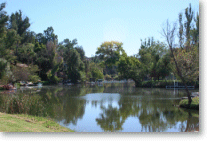 Some residents feared that the lake would take ten years to fill, or that it would empty through an unrecognized underground cleft. Finally, on April 5, 1926, a late spring storm produced nearly five inches of rain. The vast hillsides of the Santa Monica Mountains drained millions of gallons of water into Medea and Triunfo Creeks and filled Malibou Lake for the first time. The Mountain Club's founding members reportedly threw a party that lasted for several days.
Some residents feared that the lake would take ten years to fill, or that it would empty through an unrecognized underground cleft. Finally, on April 5, 1926, a late spring storm produced nearly five inches of rain. The vast hillsides of the Santa Monica Mountains drained millions of gallons of water into Medea and Triunfo Creeks and filled Malibou Lake for the first time. The Mountain Club's founding members reportedly threw a party that lasted for several days.
Contrary to popular rumor and the embellished selling pitches of creative real estate agents, legendary film director Cecil B. DeMille was not one of Malibou Lake’s original developers, but rather just one of its frequent visitors. The lake does, however, have a long history of being used by both movie and television producers in all types of genres. Many famous directors have taken advantage of this scenic locale for some of their most well-known films: Lewis Milestone's All Quiet on the Western Front (1930) starring Louis Wolheim and Lewis Ayresl; James Whale's Frankenstein (1931) starring Colin Clive and Boris Karloff; George Stevens' Quality Street (1937) starring Katharine Hepburn and Franchot Tone; Frank Lloyd's Wells Fargo (1937) starring Joel McCrea and Frances Dee; Archie Mayo's The Adventures of Marco Polo (1938) starring Gary Cooper and Sigrid Gurie; Norman Taurog's The Adventures of Tom Sawyer (1938) starring Tommy Kelly and Jackie Moran; Victor Fleming's Gone With the Wind (1939) starring Clark Gable and Vivien Leigh; and Henry Hathaway's Home in Indiana (1944) starring Walter Brennan and Charlotte Greenwood. In Frankenstein (1931), the classic screen adaptation of Mary Shelley's novel, Malibou Lake’s shore is where the monster (Boris Karloff) enjoys some quality time picking flowers with Maria (Marilyn Harris) before her subsequent drowning throws the entire town into a state of panic and chaos. Typically, when a location is used by major studios and favored by preeminent directors, it will soon appear in lower budget films. The case of Malibou Lake was no exception. Two of Republic Pictures' B-Western productions to incorporate Malibou Lake as a backdrop include R.G. Springsteen's Home on the Range (1946) and Lesley Selander's Out California Way (1946), both starring Monte Hale and Adrian Booth and both filmed in Cinecolor (two-strip Technicolor).
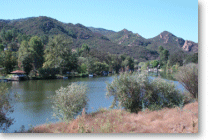 Malibou Lake and its grounds are under private ownership and may be accessed only as a personal guest of a Malibou Lake Mountain Club member. Guests using the lake or any of its facilities must be physically accompanied by the club member or have a valid and current guest pass. To protect the experience of club members and those who choose to rent their facilities, the Malibou Lake Mountain Club (MLMC) retains a private security team and strictly enforces all trespass, parking and fishing regulations. To reach Malibou Lake from downtown Los Angeles, Hollywood or the San Fernando Valley, take Ventura Freeway (Highway 101 West), exit Kanan Road, turn left and cross over the freeway.
Malibou Lake and its grounds are under private ownership and may be accessed only as a personal guest of a Malibou Lake Mountain Club member. Guests using the lake or any of its facilities must be physically accompanied by the club member or have a valid and current guest pass. To protect the experience of club members and those who choose to rent their facilities, the Malibou Lake Mountain Club (MLMC) retains a private security team and strictly enforces all trespass, parking and fishing regulations. To reach Malibou Lake from downtown Los Angeles, Hollywood or the San Fernando Valley, take Ventura Freeway (Highway 101 West), exit Kanan Road, turn left and cross over the freeway.
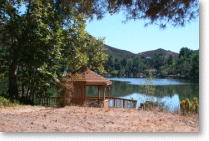 Turn left onto Cornell Way, go 2.7 miles and Cornell Road turns into Lake Vista Drive. Cross over the bridge and Malibou Lake will be on the left (south side of Lake Vista Drive).
Turn left onto Cornell Way, go 2.7 miles and Cornell Road turns into Lake Vista Drive. Cross over the bridge and Malibou Lake will be on the left (south side of Lake Vista Drive).
The water of Malibou Lake flows over the dam and finds its way to the ocean at the Malibu Lagoon. Next to Malibu Lagoon is the Adamson House, which today is a museum highlighting the history of the Malibu area and the Rindge family who fought to keep it pristine. The house and grounds share one of the most spectacular beach locations in Southern California. Visitors to the house are afforded stunning views of Malibu Lagoon, Malibu Beach and the Malibu Pier.